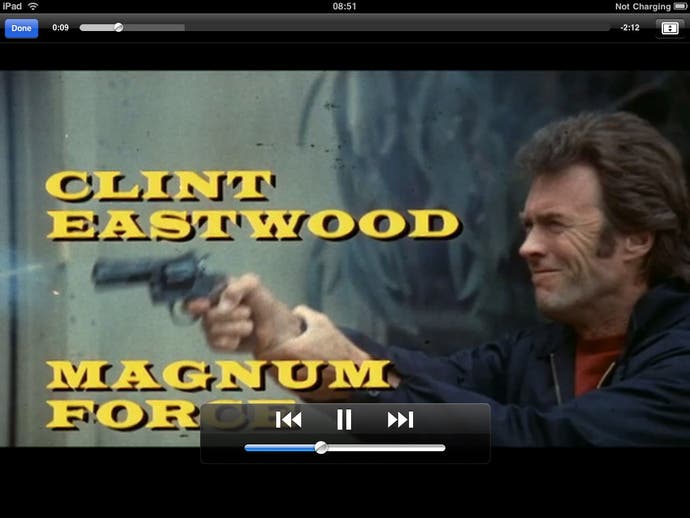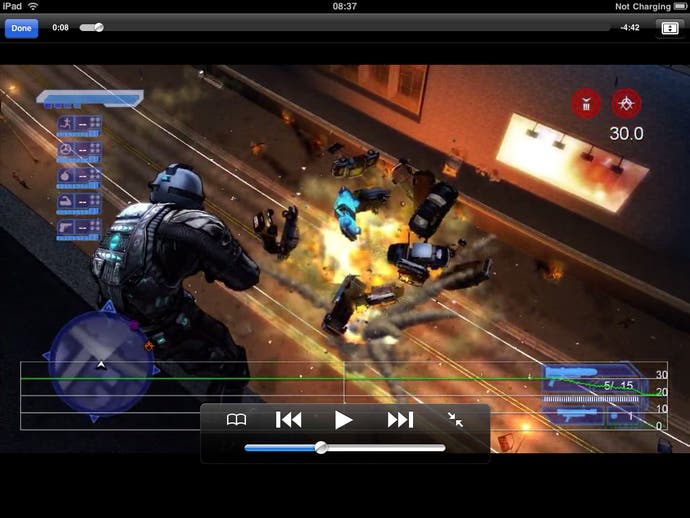Digital Foundry vs. iPad
The next big small thing dissected.
You can get a good sense of what the iPad is all about by taking it to bits, and master tear-down specialists iFixit have done just that, saving us the aggravation of exploding our highly expensive US import.
First impressions are that the machine is very elegantly made, with a surprising amount of empty space contained therein. It's difficult to avoid the impression that the iPad - at its most basic core - is a mobile telephone logic board paired up with a relatively enormous battery, but when you think about it, it's clearly the most sensible approach Apple could have taken.
Dominating the main board is Apple's A4 chip. This combines the ARM Cortex A8 CPU running at an impressive 1GHz with the same PowerVR SGX535 graphics chip found in the iPhone 3GS, all in one discreet package.
There's a die-shrink from 65nm in the 3GS down to 45nm for the A4 in iPad, and this, combined with twin (!) 3.75V batteries is the secret behind the simply astounding battery life you get with the new Apple tablet. In terms of onboard RAM, the iPad shares the same 256MB capacity as the 3GS. In the basic Wi-Fi-only iPad, there's support for all flavours of WLAN up to the fastest "N" standard (not available in the 3GS), with Bluetooth 2.1 also supported.
Having some idea of the make-up of the internals better informs us for the rest of this piece, which examines in more depth the media and gaming experiences you get with the new tablet.


In terms of media playback it's fair to say the iPad is pleasantly surprising. Apple's rendition of h264 has long been criticised for being a substandard implementation, which doesn't fully exercise the power of the codec. However, there have been some interesting reports of people getting some measure of impressive playback performance from the iPhone 3GS - there's even been discussion about 1080p content working on the diminutive smartphone.
Encoding issues apart, also problematic is the fact Apple has opted for an old-skool 4:3 display for the iPad, with a resolution of 1024x768. What this means is that the average widescreen TV show will only ever display at a maximum res of 1024x576, while cinemascope movies will get even less resolution at just 1024x436.
Similar to the iPhone you can zoom in, although obviously you lose the left and right sections of the image. However, iPhone's 3:2 aspect ratio crops off far less with zoom engaged, and with the iPad, the resounding conclusion is that too much of the image is tossed away for the sake of a "bigger" picture, so letterboxed video it is then.
Our own experiments with iPad video encoding took two very different but logical directions. First of all we used the open source x264 encoder, in combination with the MeGUI front-end, to whip up some of our own homebrew iPad encodes: widescreen content encoded at the native 1024x576.
MeGUI's "very high quality" iPhone preset was used, which allocates bandwidth according to the complexity of the image. A quick look at the preset profile shows a setup that is very close to Apple's recommended spec: main level h264, three reference frames, the whole shooting match.
The result, about 700MB for 40 minutes of 576p TV, was very watchable with absolutely no compatibility issues. However, 1.5 hours of encoding for 40 minutes of content on a 2.6GHz Core 2 Duo laptop wasn't exactly fantastic performance.
It turns out that the iPad's h264 decoder is significantly better than even Apple itself seems to give it credit for. Many video encoders prefer to use the MKV container. It's open source, it supports practically every video and audio codec known to man, and it's even been adopted by the DivX group for its own stab at HD video.
The iPad doesn't support MKV natively, but using another open source tool called GOTSent converts just about any existing HD file you might have into an MP4 that works not just on your iPad, but also on your PS3 and Xbox 360.
While audio is re-encoded to the AAC compression system, video is left completely untouched, so you can build up a high-definition media library that works on both your living room systems and now on mobile too. While you can save space by going for native iPad encodes, the bottom line is that convenience rules here and systems that simply re-encode the audio and re-package the movie into MP4 are far, far faster than recompressing the video too.
The proof of the pudding is in the tasting of course, and while the presence of black borders is a bit of a disappointment, in many ways iPad truly is the best handheld media player we've ever used. Screen quality is sensational, contrast is superb, and even with the reduced window of resolution for widescreen content, there's still a clear perception that this is a portable high-definition media player.
Sounds cool eh? Well, the best news has been reserved for last. The iPad's 10-hour battery appears to be becoming the stuff of legend, and it's a reputation well deserved. Here's the really staggering thing about HD video playback: those 40 minutes of content are only costing the battery about five to six per cent of total capacity. Phenomenal. Amazing, even. For those of us often stuck on planes and trains, the quality of the mobile movie experience, combined with its sheer longevity make it an essential purchase.


In terms of streaming internet media, the lack of Flash supports means that much online video content is denied to iPad owners. However, the YouTube app as seen on iPhone is present and correct, and supports YouTube's 720p HD encodes by default (again, downscaled to accommodate the screen). Overall quality is acceptable, but gaming footage in particular suffers badly from the scaled-back HD profile and minimal bandwidth (2mbps) that YouTube affords high-def content.
Also worth mentioning for those with large media libraries is that the Air Video app is available on iTunes and allows you to transcode and stream video across Wi-Fi, or even 3G if you can accept the inevitable poor quality. Real-time transcoding of video at the iPad's native screen resolution does require a fair bit of CPU welly on the PC hosting your media though.
Rounding off the media aspect of the iPad is the inclusion of the iPod app. This offers much the same functionality as the existing version, albeit redesigned to make better use of the extra space.
However, there is one notable difference in terms of performance: the internal loudspeaker offers a decent quality sound bearing in mind its size. While using the speaker for music might be pushing things a bit, it's certainly more than good enough for listening to podcasts or even streaming radio apps (the official BBC News app - cruelly withheld from UK license-fee payers for now - has a radio feed).
